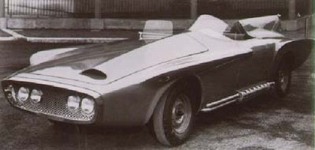
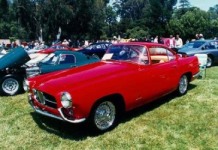
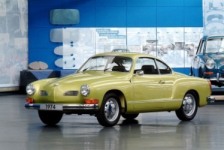

G H I A




Latest change: 8 October, 2005
Created: October, 1995
This is one of the oldest site on the Net, covering the history of the once-famous Ghia carozzeria, which has now been absorbed by Ford.
Giacinto Ghia and Carozzerie Ghia is ranked among the finest of the coachbuilders or as the Italian term say: carozzeria. They created some of the most beautiful bodies, but unlike Bertone and Pininfarina Ghia never ventured into production of cars, they focused solely on design.
History of Ghia
Giacinto Ghia was born in Turin on 18 September, 1887. After the elementary
schools he became an apprentice at various carriage builders but decided: the
motor age is coming so he entered into the new and exciting world of the motor
vehicle. He progressed from mere mechanic to the more exciting job of testing
news cars. He switched from company to company. This lasted until 1915 when
he seriously injured at a wheel of a Diatto.
He was out of a job, but he soon got a contract to build the socca
- the wooden framework- of car bodies for Diattos.
 In 1921 Ghia, with his partner, Gariglio moved to new premises at 4 Corso
Valentino (since renamed Corso Marconi, and now the site of Fiat's headquarters).
In 1921 Ghia, with his partner, Gariglio moved to new premises at 4 Corso
Valentino (since renamed Corso Marconi, and now the site of Fiat's headquarters).
From his pre-war desings best known is the
Fiat 508 Ballilla sports coupé, introduced at the Turin
concours in 1933.
But he bodied a Chrysler and other Lancia, Fiat, Isotta and Alfa models as well.
During the 2nd World War everything was ruined. Giacinto Ghia was deeply
affected by the loss: evacuated to the outskirts of Turin, he had just
returned to supervise the rebuilding of his factory when he was suddenly taken
ill and died on 21 February, 1944.
Ghia's widow offered the remnants of the company to good friends: Giorgio
Albert and Felice Mario Boano.
Boano decided that a new place is required so he transferred the operations
to a new site on the via Tommaso Grossi. The new location was close to
the railway, so that bodies could readily be shipped abroad.
Boano's postwar styling was easily recognized by the enveloped wheels.
In 1950 Fiat had asked Chrysler in America for assistance in the training of
its technicians in the lates mechaning and assembly techniques. In return,
Chrysler decided that it lacked the syling and bodybuilding expertise that was
found in Turin, and established contacts with Pinin Farina and Ghia.
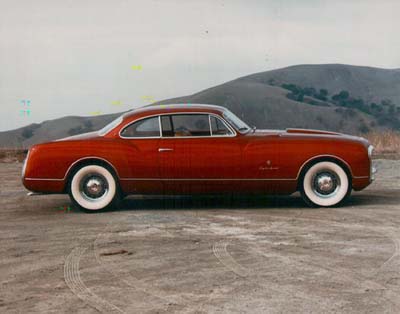
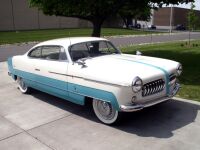 To handle the newly-forged links with Chrysler, Boano brought in Luigi Segre, a
remarkable designer/businessman (coomercial director of SIATA), aged only 30.
To handle the newly-forged links with Chrysler, Boano brought in Luigi Segre, a
remarkable designer/businessman (coomercial director of SIATA), aged only 30.
Segre and
C.B. Thomas, Chrysler vice president (president of export sales)
became friends and there were other reasons why Segre supported the foreign contracts.
Boano didn't support them, so there were personality differences and by the end of 1953
Segre was in complete control.
From the early post-war designs there were some, which are often credited to
someone else: e.g. the Lancia Aurelia B20 coupé. Ghia wanted to keep up with
small-scale (say, one-off) production so the production after 98 bodyshells
were transferred to Pininfarina, an 'industrialized' coachbuilder.
In 2005 a one-off Lancia Aurelia coupe,, designed by Boano and built by Ghia was offered for sale by Hyman Ltd.
Ghia also designed the Alfa Romeo Giulietta Sprint, 1952 which put Bertone into the big time.
But Ghia also bodied Rolls-Royces, Ferraris (sic!) and lots of Fiats and Abarthes.
The first true Chrysler-Ghia model was the K310
in 1952.
Next year, while worked for Chrysler, Ghia also created a
coupé on Fiat 8V base. This was the
start of the Supersonic body-style, the work of Savonuzzi who previously
did some extraordinary work at Cisitalia.
Other fine examples of this body-style were made on
Jaguar and
Alfa Romeo base.
This was also the time when the Volkswagen Beetle cabriolet,
by Karmann was transformed by Ghia and so the
Karmann-Ghia [external link] was born.
Ghia also created some bulbous prototypes during these years: the
Gilda prototype and the
original Batmobile, the Lincoln Futura both in
1955.
While the coperation with Chrysler progressed they also worked on Mercedes, Jaguar, Armstrong Siddeley etc and produced a small series of Jolly fun cars..
In 1957, after designing the Volvo P1800 coupé [external link] Ghia moved again, taking over premises in the via Agostino de Montefeltro formerly occupied by a small steel milling and laminating company in order to increase output.
In 1959 entered Tom Tjaarda, a designer from Finland. He designed the Selene
I, which was then shipped to Moscow and later, the University of Moscow designed
a taxicab, based upon the ideas of the Selene.
David Burgess-Wise quotes Tjaarda who said his car was used as a base for a
taxicab, designed in Moscow. "Som years later, Tom Tjaarda was surprised
to receive some photographs of a Moscow taxi that was obviously inspired by
his Selene, but ineptly executed: 'It eas horrible!' - states in his book
Mr. Burgess-Wise. Remember the year is 1959.
In the 1992 edition of the yearbook of the Swiss automobile weekly, Automobil Revue
Dolmatovsky wrote the history of his cars, under the title: "To the
history of the MPVs" (Zur Geschichte des Grossraum-Pw).
The cars which have been desribed and illustrated there are not the most beautiful
models designed ever but they surely pre-date the Selene AND have similarities
in the concept: cab-forward design, layout etc.
There's the NAMI-013 which was completed in 1952. The taxi which was dubbed
by Tjaarda as horrible and which was featured in several Central and East European car magazines at the time was born in the winter of 1965/66. There's IMHO little impact of the Selene and it looks beautiful. That's about the Selene-Dolmatovsky connection.
Back in 1959, Ghia had built an odd Exner-designed Plymouth sports car, the XNR, in which the two halves of the cars were assymetrical, hence the nickname Assimetrica, a massive bulge over the offset engine adding to the oddly imbalanced effect. A Chrysler Falcon based version was bought by Georges Simenon.
Exner left Chrysler in 1961, Segre died two years later. The Chrysler connection discontinued, the ownership of the company changed from hands to hands 'til Alejandro de Tomaso bougiht it.
Before that Ghia built the bodies of the DeTomaso Vallelunga. In 1965 the
head of design job was offered to Giorgio Giugiaro (he replaced Coggiola, a
not-so-well-known car designer).
This was the times when they transformed into metal Exner's free-lance idea:
a Bugatti 101C based cabriolet. It was odd.
There was a short spell, when it seemed that Ghia should design the AC Cobra facelift. It didn't happen so De Tomaso comissioned Ghia (aka Giugiaro) to design a new rear-engined sports car: it would be called Mangusta, Italian for 'mongoose' - the deadly enemy of the Cobra.
In 1967 De Tomaso took over the control of the company. Most of the designers
immeadiately left the company. "With De Tomaso, I could do nothing. He was
impossible!" - said later one of them.
The Mangusta entered into production in 1968. The body/chassis was completed
at Ghia, powerplant was fitted in Modena at De Tomaso.
Giugiaro, who acted now as a free-lance soon established ItalDesign.
Ghia focused on DeTomaso and other Italian exotics: Iso Rivolta S4, Serenissima
etc.
In August 1969, Lee Iacoocca, then Ford manager visited Ghia. An agreement was announced soon: it is contemplated that Ghia/ De Tomaso will build a number of Ford engineering prototypes, show cars and limited-build specialty vehicles.
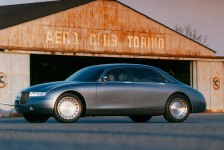
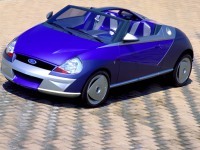
Financial difficulties at De Tomaso arose, when his men who backed him died
in an accident. He sold most of his shares to Ford in 1970
The De Tomaso Pantera project, which started a year before switched into
full gear. Ghia designed the DeTomaso luxury model, named Deauville as well.
From the '70s on Ghia, in the hands of Ford designed some one-offs, but lost
most of his carisma.
In the '90s there were numerous Ford-based prototypes, which never materialized: Focus, 1992, Aston Martin Lagonda Vignale, 1993, Vivace, 1994, Ford Saetta, 1996 - which became the Pininfarina-built Ford StreetKa and others
In 2002 Ford sold the better part of its historic prototype-collection and with that many Ghia-built prototypes.
Today Ghia is a "virtual design studio" in Turin and a trim level of various Ford models worldwide.
Acknowledgements:
First and foremost to David Burgess-Wise. His work: Ghia Ford's carrozzerie,
subtitled "A study of one of Italy's oldest and finest coachbuilders",
was published by Osprey in 1985. (ISBN 0-85045-625-8). It is the basis of this page. I spoke with Mr. Wise during the mid-1990s and he said he wouldn't mind if I quote his text. THANKS!
Also: Dave Sisson, Barrett-Jackson, Mark Hyman and the former Ghia archives.
Some paragraphs were taken from Edward Jankicki's excellent book: Cars
Detroit Never Built. 1990. ISBN 0-8069-7424-9.
Diclaimer: please drop me a note before obtain contents of KTUD Archive. I am not related to Ford or Ghia, but has received permission from the then-existing Ghia studio in the mid-1990s to publish some of their archive materials on the Web.